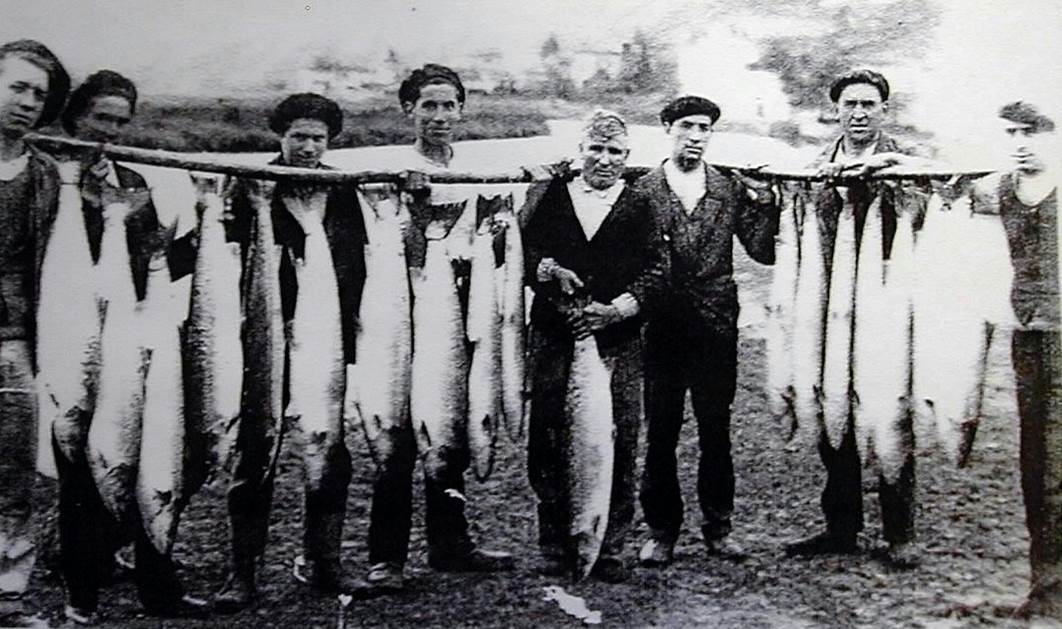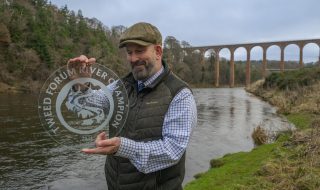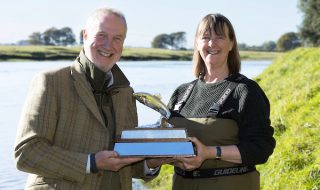Pic: Fishermen netting Atlantic salmon in the River Ason (N. Spain) c.. 1930’s
Pre-historic hunters didn’t need to tell the story about the one that got away —the fish they caught really were whoppers, according to a new study carried out by scientists from Swansea and Spain.
Swansea University Professor Carlos Garcia de Leaniz joined his colleagues Dr. Pablo Turrero and Professor Eva Garcia-Vazquez from the University of Oviedo, Asturias, Spain in a study which compared the backbones of about 30 Atlantic salmon and brown trout specimens unearthed at ten prehistoric sites in Asturias, northern Spain, with those of their living descendants.
The study published in the journal Royal Society Open Science last week concluded that the size of salmon and trout caught by Upper Palaeolithic fishermen were much larger than today’s fish, and decreased rapidly from 12,000 years to approximately 6,000 years before present. The most obvious explanation for this finding is the overexploitation of large fish by ancient fishermen, though changes in the productivity of aquatic habitats cannot be ruled out.
A trend for shrinking sizes starts to show up in the cave fish fossils about 10,000 years ago, “but size selection had been going on all the time,” said Dr. Turrero who led the study. The fossils also indicate that the modern humans who replaced the Neanderthals some 40,000 years ago were serious about fishing “pretty much as soon as they started settling in the region,” according to Turrero. Often burnt, the fish fossils show that hunters “would catch the fish in the nearest stream, then bring them to the cave to cook by the fire,” he said.
“ People think that fishing only started causing an impact on the size of fish recently, with the development of modern gears and sophisticated detection methods, but our study suggests that fishers may have been selecting for large fish for a long time”, says Professor Carlos Garcia de Leaniz , Chair in Aquatic BioSciences at Swansea University.
“The problem with large fish is that they are usually easier to detect, and also easier to catch. We do not know for sure how our ancestors fished for salmon or trout but evidence suggests they may have used spears and possibly also rough traps made of tree branches and stones, much the same as some Amerindians still do today. They would have inadvertently selected for large fish because small ones would have found it easier to slip through”.
“A lot is really staked against large salmon, particularly large females”, adds Carlos, ‘because large females tend to swim further upstream into the headwaters of rivers to spawn – where they are easy to catch – than small fish, which tend to spawn lower in the river. The only thing in favour of large fish is that if they survive, they would leave more eggs.”
“The method we have developed with our colleagues at the University of Oviedo allows us to estimate the size of salmon from the size of their vertebrae found among food remains. This is very exciting because it will allow people to reconstruct the size of ancient fish and examine the evolution of fisheries with much greater precision’, concludes Carlos.
The study “Shrinking fish: comparisons of prehistoric and contemporary salmonids indicate decreasing size at age across millennia” has been published in the Royal Society Open Science journal. Find the study here: http://rsos.royalsocietypublishing.org/content/1/2/140026
Picture: Fisherman using a rod and line, holding a large salmon, River Nansa (N. Spain) c. Early 1930’s.






